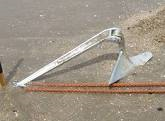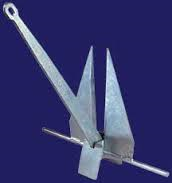Selecting The Proper Anchor For Your Sailboat
Anchoring is one of the many joys of sailing. It allows you to visit sheltered coves, explore distant shores, and experience the tranquility of nature. Many sailors, however, do not enjoy anchoring for a variety of reasons mostly attributed to a lack of knowledge and experience. My intention is to share some of my experiences with you and explain what has worked best for me and my sailboat. In this first of three articles covering anchoring skills, I will discuss the importance of selecting the proper anchor for your sailboat.
With so much investment literally riding on your anchor, your sailboats ground tackle (consisting of anchor, chain, and rope) is no place to cut expenses. An anchor is an essential piece of safety equipment but unfortunately not Coast Guard required. ( see CG required safety equipment ) When choosing an anchor look for superior construction features such as heavy duty components, strong welds, and quality galvanization. You should have at least one anchor for each bottom type you expect to anchor on. You will also need two (bow and stern) anchors in tight anchorages affected by currents.
Anchor Types
There are many styles and categories of anchors used for the various conditions and situations. In this article I will focus on the two most common anchors used by most cruisers aboard their sailboats, the fluke and plow types.
Fluke (Danforth) Type
This popular burying anchor has wide, sharp flukes. Its excellent holding power-to-weight ratio means it can be lighter than some other types of anchors used for the same conditions. Fluke type anchors hold very well in soft bottoms like mud and sand. The drawbacks to the fluke type anchor is that the flukes can be fouled by seaweed or rocks preventing the anchor from setting well. They are also somewhat cumbersome and do not stow well on deck. A high tensile aluminum model from Fortress is relatively lighter but has excellent holding power. In very soft mud or hard sand these anchors will often hold well when other anchors fail. The angle of attack of the flukes on the Fortress can be set to better accommodate mud or sand. However, due to their light weight the Fortress tends to slide on grass and skip over rocks preventing a good set. All anchors have one or more drawbacks, however the Fluke Type of anchors have been very successful over the years.
Plow (CQR) Type
 Plow anchors have excellent structural strength, but do not penetrate as deeply into the bottom as fluke style anchors. On the other hand they tend to set more easily due to their increased weight. It is the anchor of choice in sand, light grass, and rocky bottoms. An efficient anchor, the original patented CQR features a swivel at the shank base which inhibits it from breaking out when the current or wind causes the sailboat to change direction. The CQR is expensive but is found on more long term cruisers than any other anchor because of its construction, versatility, and reliability. It stows well on the bow roller making it easy to launch quickly in an emergency. Retrieval is also much less cumbersome than the fluke type anchors. There are many deviations on the plow (CQR) type, each claiming to be the best. They include Bruce, Delta, and Claw, all now distributed by
Lewmar
.
Plow anchors have excellent structural strength, but do not penetrate as deeply into the bottom as fluke style anchors. On the other hand they tend to set more easily due to their increased weight. It is the anchor of choice in sand, light grass, and rocky bottoms. An efficient anchor, the original patented CQR features a swivel at the shank base which inhibits it from breaking out when the current or wind causes the sailboat to change direction. The CQR is expensive but is found on more long term cruisers than any other anchor because of its construction, versatility, and reliability. It stows well on the bow roller making it easy to launch quickly in an emergency. Retrieval is also much less cumbersome than the fluke type anchors. There are many deviations on the plow (CQR) type, each claiming to be the best. They include Bruce, Delta, and Claw, all now distributed by
Lewmar
.
No single anchor design is best in all conditions, so have aboard at least two anchors of different designs to handle varying conditions. Thus, the most critical consideration when selecting the proper anchor will be the bottom conditions in the areas you want to visit. Finally, keep an anchor stored in such a way that it is ready to deploy at a moments notice. On our Catalina 30 sailboat which we have sailed and anchored successfully from Cape Cod to Maryland we carry 3 anchors. A 35 pound Delta plow on the bow roller, a 20 pound Danforth in the anchor locker (bow), and a Fortress in the aft locker. In the next article we will discuss the proper chain and line to attach to your anchor, completing your ground tackle.

 Barnegat Bay Sailing Charters, 100 Harbor Inn Rd., Bayville, NJ 08721
Barnegat Bay Sailing Charters, 100 Harbor Inn Rd., Bayville, NJ 08721
One comment
[…] that you have selected the proper anchor for your sailboat it is next essential that we assist you in selecting the proper anchor rode. Depending on the size […]